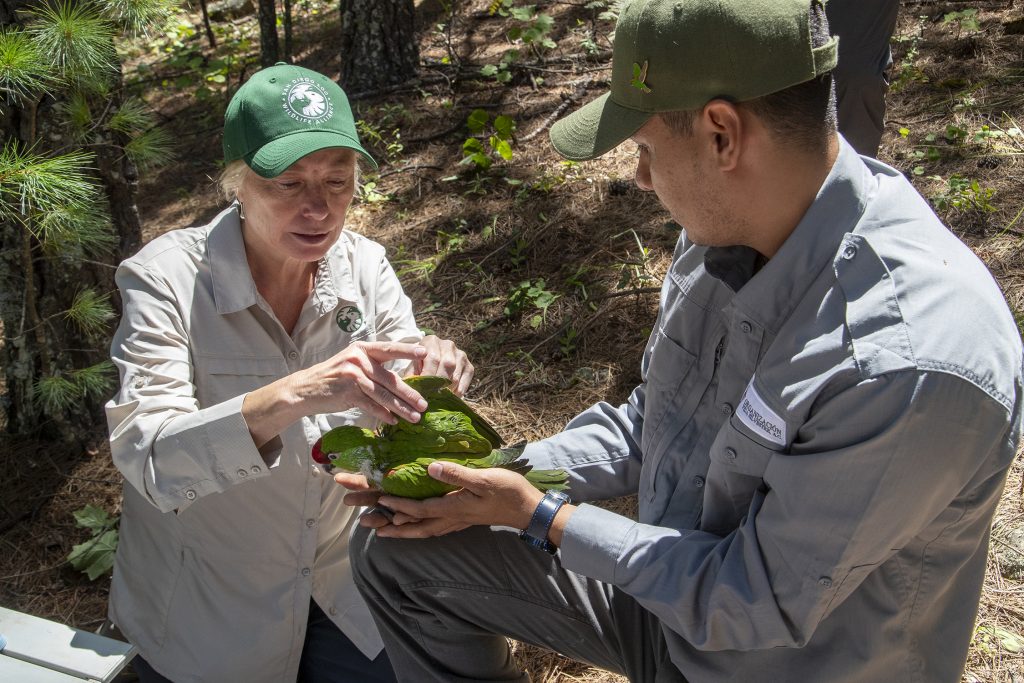The thick-billed parrot (Rhynchopsitta pachyrhyncha) is a riot of colour; lime green feathers with pops of scarlet, and bright, yellow-ringed eyes. In the high-altitude pine forests of northern Mexico, these striking and raucous birds feast on pine cones, using their powerful beaks to pull apart the dense cones to get at the seeds nestled inside.
But it was the thick-billed parrot’s plight, not their plumage, that caught the attention of veterinarian Dr Nadine Lamberski. While working at Sacramento Zoo in the early ‘90s as part of her veterinary residency, Lamberski learned of the many threats to the species’ survival. Today, thick-billed parrots are classified as endangered, due to pressures such as deforestation, disease, hunting and illegal wildlife trade.
At a meeting in Arizona a few years later to discuss reintroductions and relocations of the thick-billed parrots, Lamberski spoke up about the importance of veterinary expertise in ensuring the health and long-term survival of these populations. This set her on the course to become a world leader in conservation and wildlife health, working out of San Diego Zoo Safari Park – a vital hub in a global wildlife conservation alliance.
Species saver
Lamberski’s love of nature and a desire to do something meaningful with her life have been present in her from a very young age. After graduating from veterinary school at the University of Georgia in the United States, she completed an internship at the University of Tennesee and Knoxville Zoo. She then did a residency in zoo medicine at the University of California, Davis, which provides veterinary services to the Sacramento Zoo.
“By the time I got through vet school, I was young and eager and wanted to save the world,” she says.
I wanted to do something that would have a lasting impact, but it wasn’t clear to me how to do that, and what the opportunities were.
Then, the thick-billed parrot flew into her life. “I started to realise that in order to provide the best care to my patients, I needed to better understand what their lives were like in their native habitats,” she says. “And, at the same time, I realised how the skills and expertise that we’re developing at a zoo can be applied in a larger context and benefit birds in their native habitats.”
Credit: San Diego Zoo Wildlife Alliance
In 2001, Lamberski joined San Diego Zoo Safari Park as senior veterinarian, then worked her way to becoming the zoo’s chief animal health officer in 2016. A few years later, the COVID-19 pandemic led to sweeping changes at the zoo, which resulted in Lamberski being not only responsible for the care of animals within the zoo’s boundaries, but for those in biodiverse regions around the world.
Global collaborations
Lamberski now oversees San Diego Zoo Wildlife Alliance’s conservation efforts across eight conservation hubs. She collaborates with a team of 300 scientists, veterinarians, technicians and conservation professionals who are working to protect species across the globe.
Her team works with local partners on activities such as remote sensing in forests to evaluate the biodiversity; trail cameras and acoustic recorders to monitor the movement of animals; and environmental DNA studies to detect which animals live or pass through an area, and which pathogens might be a threat to them.
“One of the coolest things that we’re helping to put into practice with our partners is syndromic surveillance,” Lamberski says, referring to a type of surveillance that looks for symptoms of specific diseases or infections. Using a platform called EarthRanger on their phones, rangers deployed across northern Kenya can monitor wildlife populations for symptoms of disease, as well as deaths in large species such as elephants and giraffes.
Important conservation work also happens at San Diego Zoo itself. Lamberski’s team oversees an invaluable repository, or biobank, known as the Frozen Zoo which houses more than 11,000 biological samples of plant and animal species. Samples in the biobank can be accessed by conservation researchers from around the world.
Shared experiences
What people see when they visit a zoo is a small fraction of the work these institutions do to protect threatened species. Collaborating with local and Indigenous communities across the globe, zoo staff are using the knowledge and experience they gain from managing species in confined spaces to inform conservation efforts in their native habitats.
Zoos have always cared about wildlife and the places and the countries that their wildlife comes from.
“Zoos are trying to do more now, because populations are disappearing, and our skillsets as wildlife care professionals is recognised globally.”
Lamberski acknowledges that their efforts can only truly succeed if people are able to change their behavior to reduce the threats of biodiversity loss, habitat degradation, pollution and climate change. “A significant challenge would be getting people to recognise that many things that they do on a daily basis impacts the future of our planet for good or for bad,” she says.
One example that she’s particularly focused on is food waste. “I’m trying to waste less food, I’m trying to buy less food, and it really concerns me when I go to a restaurant and there’s so much wasted food on the plate,” she says. It’s something that individuals can address in their own lives, that ultimately has enormous flow-on effects for the planet. “People have the power within themselves to make choices that are healthy for ourselves, for the wildlife, for the habitats. It’s all in our control.”
Story by Bianca Nogrady

